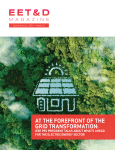It’s well understood that the world’s aging power grids are rife with problems. However, replacing major portions of the grid assets to fix those problems is not realistic, so the challenge facing utility leaders becomes how to do more with existing assets. Moreover, the challenge is how to wring more out of existing assets with solutions that won’t take ages to implement or are cost-prohibitive. With a focus firmly on improving existing assets, challenges and opportunities can be placed into three main categories: capacity optimization, asset health and grid reliability.
For this article, I'll focus on the first opportunity: capacity optimization. Capacity optimization unblocks the renewable energy interconnection queue by finding and leveraging untapped grid capacity, making power transmission more efficient and cost-effective.
Two innovative technologies, Dynamic Line Rating (DLR) and Ambient Adjusted Rating (AAR), are igniting the transformation to capacity optimization by unlocking the latent capacity of power lines. DLR and AAR technologies, which leverage real-time and forecast weather data and conductor condition monitoring, are at the forefront of increasing grid capacity.
Dynamic Line Rating (DLR): DLR uses sensors installed on critical sections of power lines, or attached to the transmission towers, to constantly collect data on parameters such as current, sag, conductor temperature and wind speed. Algorithms use this real-time information, combined with weather data, to accurately estimate the capacity of a line. By dynamically adjusting line ratings based on environmental conditions, DLR enhances grid efficiency.
One notable example of DLR in action is PPL’s award-winning capacity optimization project. PPL, one of the leading electric utilities known for its cutting-edge power grid and customer focus, was faced with grid congestion and high nodal prices. Rather than undertake expensive network upgrades, the bellwether opted to implement DLR, which proved to be 90% more cost-effective. This choice allowed PPL to increase line capacity by 20% for 90% of the time, leading to more reliable power supply.
Ambient Adjusted Ratings (AAR): AAR does not use sensors. Instead, it leverages atmospheric data from third parties to optimize capacity. While simpler and more cost-effective than DLR, AAR lacks sensor-driven data about wind's cooling effect, which means it typically yields lower capacity gains than DLR. Yet those gains are critical. The Federal Energy Regulatory Commission's Order 881, mandates that by 2024 all transmission line owners leverage AAR. The primary goal of FERC Order 881 is to enhance transparency in calculating transmission line ratings. By mandating documented and publicly available transmission line rating methodologies and using AARs, FERC aims to increase the capacity and utilization of the transmission infrastructure. AAR is a crucial element to that end. It’s worth mentioning that in addition to the focus on AAR, the FERC is also exploring the merits of DLR following order 881, so DLR could potentially be mandated as well.
Unlocking the future with DLR and AAR
DLR and AAR solutions are already well-proven and utilized in both Europe and the US, and now it’s time for more utilities to start this journey to smarter, adaptable power networks.
DLR and AAR technologies significantly improve capacity on existing overhead transmission and distribution lines – particularly during cooler or windier weather conditions. DLR produces up to 40% additional capacity 50% of the time and AAR yields a humbler and more conservative 5% to 10%. The combined benefits are significant, largely reducing locational electricity prices, deferring line upgrades and enabling improved outage windows. These are big benefits that cost about 2% of the price of alternative solutions such as reconductoring or building new lines.
FERC has done amazing work with 881 to unblock the systematic challenges and in the US, DLR could be mandated, too. This would "open the floodgates" on getting the most out of grids and benefit all. While the majority of technical and systematic challenges have been solved, significant financial hurdles still exist, and adding DLR could help solve those. DLR and AAR examples exist worldwide and they are high TRL and delivering real value. This shows it is possible. With the right financial and regulatory framework in place, all utilities could benefit from DLR and deliver value to consumers by reducing electricity prices whilst increasing the uptake of renewable energy.
Leveraging both DLR and AAR solutions is a crucial step in leveraging untapped grid capacity helping grid operators meet the surging demand for electricity. Moreover, the solutions help preserve asset health and bolster grid reliability, all of which support efficiency and cost reduction. Utilities and their customers both gain significant advantages delivered by these transformative tools.
 Brian Berry brings over 14 years of experience to the energy sector. He leads with a senior and strategic perspective at Ampacimon, where he spearheads innovative solutions to address the intricate challenges faced by power systems. His previous roles at Reactive Technologies, GE and Eskom involved technical leadership, strategy and delivery of solutions focusing on improving power system operations with stability monitoring and control.
Brian Berry brings over 14 years of experience to the energy sector. He leads with a senior and strategic perspective at Ampacimon, where he spearheads innovative solutions to address the intricate challenges faced by power systems. His previous roles at Reactive Technologies, GE and Eskom involved technical leadership, strategy and delivery of solutions focusing on improving power system operations with stability monitoring and control.






